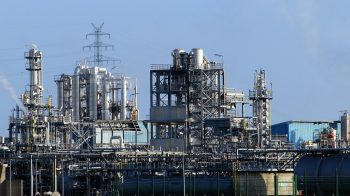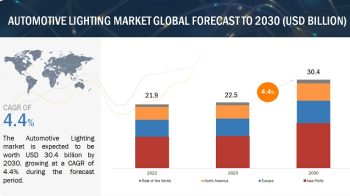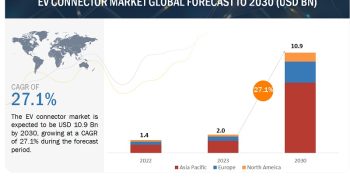Mergers & acquisitions and new product launches are the key strategies adopted by the leading players to strengthen their positions in the electroactive polymers market
The electroactive polymers market is estimated at USD 3.51 billion in 2017 and is projected to reach USD 5.12 billion by 2022, at a CAGR of 7.9% between 2017 and 2022. Mergers & acquisitions and new product launches are the key strategies adopted by the major players to strengthen their footholds in the electroactive polymers market. The Asia Pacific region, followed by the North American and European regions witnessed the maximum number of strategic developments undertaken by various players between 2012 and 2017.
Download PDF Brochure: https://www.marketsandmarkets.com/pdfdownload.asp?id=87
The key players operating in the electroactive polymers market are Solvay (Belgium), Parker Hannifin (US) Agfa-Gevaert (Belgium), 3M (US), Merck (Germany), Lubrizol (US), Novasentis (US), Premix (Finland), and PolyOne Corporation (US), among others.
Parker Hannifin (US) is one of the leading manufacturers of electroactive polymer based sensors and actuators. The company has been focusing on new product launches to maintain its leading position in the electroactive polymers market. For instance, in June 2016, the company launched the SensoNODE High-Strain sensor highlighting EAP technology. SensoNODE High-Strain is prepared with a stretchable polymer which can take precise interpretations and readings for a long period of service life.
Solvay (Belgium), and Merck (Germany) are other major players in the Electroactive Polymers Market. For instance, in January 2016, Solvay completed acquisition of the Ryton PPS (Polyphenylene Sulphide) business from Chevron Phillips Chemical Limited (US). Solvay has bought 2 Ryton PPS resin manufacturing units in Borger, Texas. The acquisition is a part of Solvay’s strategic development into a more specialized solution provider.
In November 2015, Merck (Germany) acquired Sigma-Aldrich (US), which has provided Merck the capability of serving life science clients worldwide through this acquisition with a competent set of products. This acquisition also enhanced the position of the company in the electroactive polymers market.
This report provides a detailed analysis of the electroactive polymers market and segments the same based on type, application, and region. Based on type, the market has been segmented into conductive plastics, inherently conductive polymers, and inherently dissipative polymers. Based on application, the market has been segmented into ESD protection, EMI shielding, actuators, capacitors, batteries, sensors, and others. Based on region, the market has been segmented into Asia Pacific, North America, Western Europe, Central & Eastern Europe, the Middle East & Africa, and South America.
Attributes, such as low cost of materials, ease of synthesis, lightweight, and flexibility are expected to drive the growth of the electroactive polymers market from 2017 to 2022
The Electroactive Polymers (EAPs) market is projected to reach USD 5.12 billion by 2022, at a CAGR of 7.9% between 2017 and 2022. Electroactive polymers offer ease of synthesis, as these have a flexible chemical structure. Cost of raw material is one of the major factors influencing the demand for electroactive polymers. The electroactive polymers market has been segmented on the basis of type, application, and region.
EAPs are polymers that possess electrical properties similar to metals along with the mechanical properties of polymers. Polymer doping helps enhance these properties and makes EAPs more preferable to metals or other polymers. EAPs find applications in various end-use industries because of their unique properties. Contrary to conventional materials (metals), EAP products are lighter in weight, durable, and have better conductive properties. Moreover, these polymers can develop a strain of more than 100% and have high actuation pressure per unit mass, which provide maximum (100%) change in shape. Among types, the inherently conductive polymers segment is projected to grow at the highest CAGR between 2017 and 2022. Inherently conductive polymers are undergoing extensive R&D activities, as these are also expected to have potential applications in the field of robotics, energy harvesting, coatings, medicals, and smart fabrics. Inherently conductive polymers exhibit excellent optical and electrical properties, high transparency, high environmental stability, low cost, and high process ability in comparison to other EAPs.
Electroactive Polymers (EAPs) are increasingly witnessing widespread applications in various industries around the world. Electrostatic Discharge (ESD) protection and Electromagnetic Interference (EMI) shielding are the major applications of Electroactive Polymers (EAPs) and account for the largest share in the electroactive polymers market. These are also gaining use in various applications, ranging from sensors and actuators for electronic appliances to artificial muscles and motion generating devices. Electroactive Polymers (EAPs) are being increasingly used in various applications in the electronics industry, such as sensors, actuators, batteries, capacitors, and antistatic packaging. Among applications, the actuator segment is projected to grow at the highest CAGR between 2017 and 2022. Significant R&D activities are being undertaken for various applications of EA electroactive polymers. This is helping them gain acceptance as an ideal material for actuators, energy harvesting, space applications, automation control, and other industrial applications.
The Asia Pacific electroactive polymers market is projected to grow at the highest CAGR between 2017 and 2022. The growth of the Asia Pacific electroactive polymers market can be attributed to the rising demand from Electrostatic Discharge (ESD) protection and Electromagnetic Interference (EMI) shielding applications, coupled with economic growth in the region. The European electroactive polymers market is expected to witness moderate growth during the forecast period. This moderate growth can be attributed to growth in Electrostatic Discharge (ESD) protection and Electromagnetic Interference (EMI) shielding applications as compared to other regions. The slowing down of the economies of the European region has further led to the gradual shift of the manufacturing industry to the emerging economies of the Asia Pacific, such as China and Japan.
Some of the key players operating in the electroactive polymers market are Solvay (Belgium), Parker Hannifin (US) Agfa-Gevaert (Belgium), 3M (US), Merck (Germany), Lubrizol (US), Novasentis (US), Premix (Finland), and PolyOne Corporation (US), among others. Most of these companies have adopted new product launches and mergers & acquisitions strategies to strengthen their positions in the electroactive polymers market.


